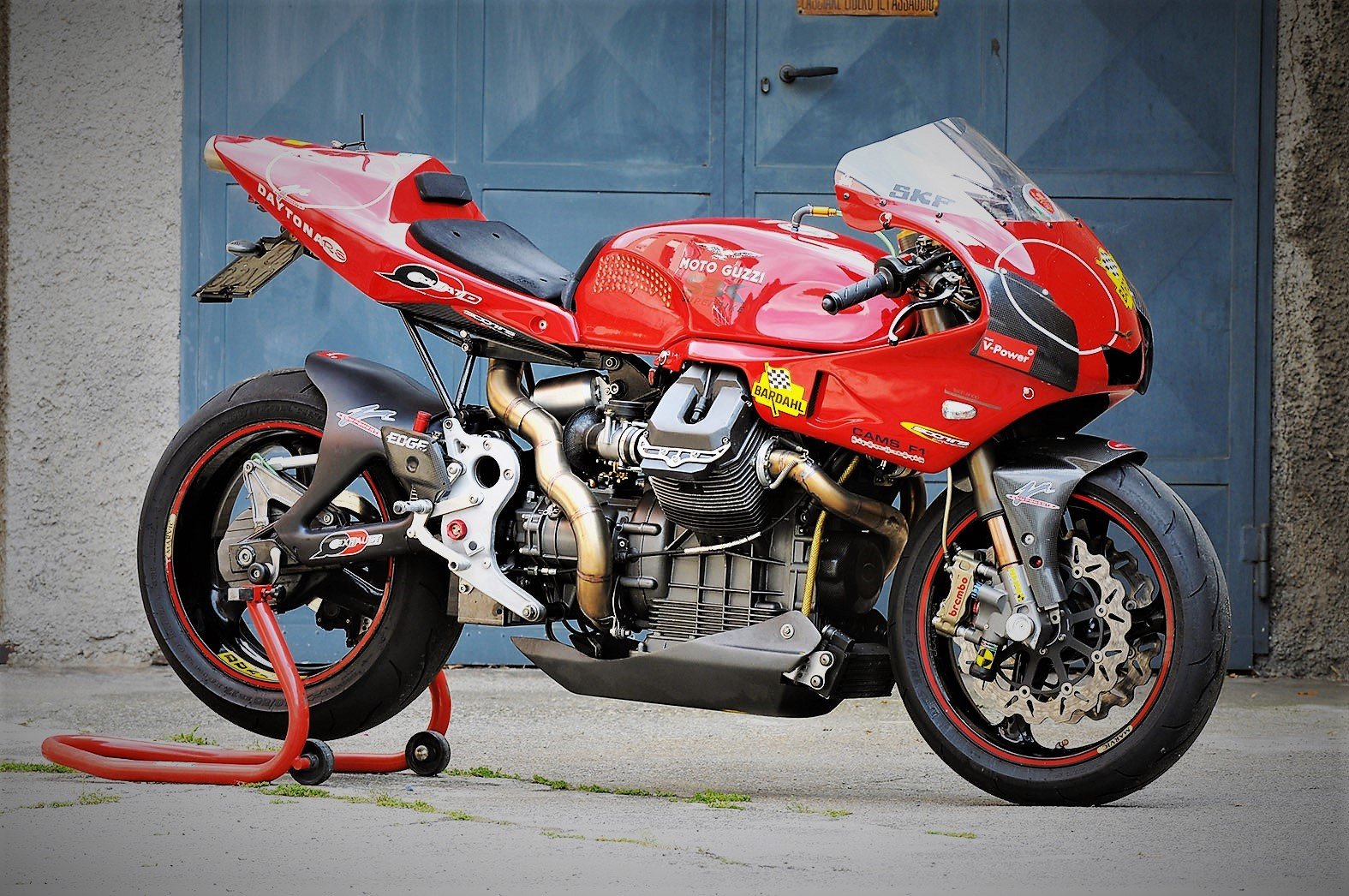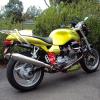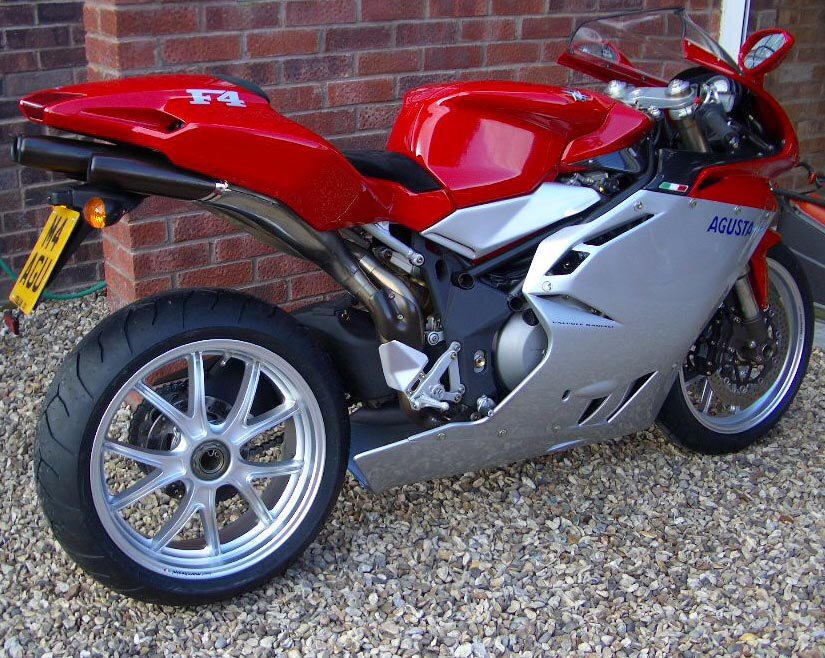-
Posts
4,540 -
Joined
-
Last visited
-
Days Won
234
Content Type
Profiles
Forums
Events
Gallery
Community Map
Everything posted by Lucky Phil
-
All new info to me docc, but thanks. It was a "thing" back in the 80's and I think my Bimota DB1 also had this. It came with 16 inch wheels front and back but i had friends that raced one in the Aus Superbike series and I converted mine over to 5x17 rear and a 3 and 1/4 x 17 front Campagnolos and ran a cut slick on the rear for the street. Arrr, youth a time when I used to hand cut my own tyres and think nothing of doing stuff like this. Ciao
-
Yes it's a proper cross over chuck, somewhat like the Stucchi but the full version where the two pipes "kiss" at the curve with a connection formed between. What creates the pulse is the sharp change in cross section more than the shape of the connection. This looks like it will work. Be interested to see a dyno comparo with the Stucchi. One thing though, I'm hoping there is rubber isolator/s on the crossover mount. There's also an extra slip joint thats not necessary on the crossover as well. Ciao
-
Look up the rake and trail specks for the original bike and then measure yours with the steel triples. I didn't know there was a "kit" for them. The difference will almost certainly be in the trail which will be changed by the offset between the steering stem centre and the fork centres. Easy to measure with a short straight edge and a tape measure across the top triple clamp if you have an original bike to compare to if not its a ground measurement.Sometimes though there is a curve ball from those days where the upper and lower triples have a different offset, I think my RC-30 was like this. I had two friends back in the 80's that both had 16" wheeled Guzzies both ex racers. One had a LM04 which he bought in Mandello when we were over there touring together and the other a T5. As I said both were ex racers and one was an "A" grader here that raced in the Castrol 6 hour a few times. Both had no complaints about the 16 inch front wheel other than the the lack of tyre choices after a while. I seem to recall at least one of them on the LM used Lazer tyres. I also had a factory Ducati TT2 back at that time I used on the track and it had a 16" front wheel and despite all the Ducatisti saying it was bad I never had an issue with it. The bike I mechaniced on in the IOM in 86 was also a factory 16" wheeled TT2 and it did practice and 2 races and then went on to do the rest of the F2 season in Europe and was never an issue on the roads or closed circuits either. Personally I think the 16" front just went out of fashion when race bikes stopped using them and people tried to justify it. Also Ducati riders especially and probably most others were used to slow steering bikes nothing like we have today and weren't used to the quicker more agile steering the 16 gave. Ducatis steered like a truck in the early 80's and Ducatisti thought that was great handling when in fact it was just a lot of stability. I remember my first ride on my RC-30 Honda over a fast piece of country road after years of riding the same road on my Hailwood Mille. I was just gobsmacked at how brilliant the Honda handling steering and suspension was. Ciao
-
Yep, not trying to worry you, it should be fine. Ciao
-
Seal instillation is more complicated than people think. I hate doing it and always have another one on hand just in case. Probably just me. Pressing in is the preferred option after getting the seal started initially but tapping with a protector/seal driver but sometimes you dont have a choice but to drive it in. Directional mono seals are better than bi directional at keeping oil in and are generally used as OEM on seals where replacement is a lot of work. Thats why I always use OEM for seals that are work to get to like crank seals and gearbox input shaft seals. Here's a new wrinkle. Some new material seals these days need to be installed dry and if you lube them they will leak. They work by depositing a layer of seal material on the running surface in the initial period of rotation. If the workshop manual doesnt say to lube the seal then install it dry. As if it wasn't complicated enough:) On the subject of seals I've bought a LOT of Viton/FKM seals lately and I asked the seal guy how you tell the difference between a black Nitrile seal and a black Viton/FKM seal. He showed me that the Viton/FKM are more a charcoal colour and the Nitrile are closer to jet black. It's a subtle difference but if you look closely you can tell the difference. Important to know for fuel and + 100 deg C heat related applications. Ciao
-
Ok, maybe just a seal issue then although I'd expect it to go for a lot more miles than that. Whenever I have a seal that fails I always look at the seal sealing lip and running surface with a mag glass for any signs of an issue. I had a friend years ago with a Hailwood Mille that had a dry clutch on his 3rd clutch seal replacement which I knew was wrong. When I looked at the primary gear seal running surface for the seal it had a spiral mark on it from the factory grinding process. Chuck is also right of course and a failed bearing is also a possibility but once again pretty low miles. Pete will have a better idea of CARC issues.The only thing I know about the CARC is the ultra rare swingarm breakage and the pinion nut coming loose and those were from reading Petes posts. 400 grit paper. Ciao
-
How many miles has it done? Ciao
-
The rear disk isn't very critical so I would just install the new pads and break them in per the manufacturers requirements and see how it performs. Not sure I'd do it any different for the fronts either. Pads work by depositing a microscopic layer of pad material on the disk but unless they are pulsing i'd just clean them with a solvent.The rider I crewed for in a WSB race years back wanted the disks rubbed with wet and dry before every session as he said it gave the brakes more initial bite. personally I couldn't see it but that's how you need to take care of the riders mentality as much as the bike. Amusing thing was though because he was a rider with a long term national profile the guys were were sharing a pit garage with were doing the same thing by race day:) Ciao
-
Meinolf's theorys are basically correct but it's just as much a matter of practicality and feel though. A lot of whats been explained can only be ratified on the dyno, flow bench and via logging lambda. One of the benefits of the Ducati Desmo system is that it allows faster opening of the valves because the rate of acceleration isnt dependant on the mechanical considerations with regards to valve spring although this has been largely negated by pneumatic valve springs now. All good info and if it results in a better running more economical engine then that's great. However at the end of the day what valve clearances you use depends ( within reason) as much on "feel" and whats best for mechanical considerations. I ran my bikes with .15 and .2 from early on and when I changed to this setting it surprised me that it actually did feel like it ran better ( I was sceptical) however I also noted the starting was a little worse. Not to worry a couple of thou from factory settings isn't going to worry me mechanically and I traded one thing (starting) for a greater gain in the way the engine ran. I'm not entirely sure I'd want to go to .25mm clearances though, just for mechanical reasons. That's .006" and .004" over the factory settings.I would be interested to see an engine thats used these clearances for 50,000 klms and see if there has been any mechanical considerations. It may have less wear,dont know. It also retards the effective valve timing fractionally which could be a good thing or not depending on how far away from spec it is due to assembly tolerances and cam chain wear etc and shortens the duration which probably isn't a benefit. If Guzzidiag was around at the time and I'd fiddled with the mapping I could have probably made the starting better. Play with the settings and see what the current engine setup likes. Ciao
-
I dont know for sure but I think it gives you greater sensitivity at the lower throttle angles where most of the usage is. I guess that they eventually decided it wasn't necessary. Meinolf or Paul will know for sure. Ciao
-
There are 2 types of PF3C TPS sensors. A linear and non linear type. They can be distinguished by the fact that one will have adjusting slots for the mount screws and one doesn't. The non linear has the slots and the linear one doesn't.The TPS setting for this type is done via Guzzidiag or the Guzzi factory software. The Non linear is the type fitted to V11's and has a voltage V output almost exactly the same as the old PF9 sensor. Ciao
-
I've posted on how to remove the swigarm bearing in 30 seconds with a home made tool Ciao
-
I like the Guzzi with the exception of the tail and seat. A bridge too far for my tastes. The exhaust looks very nice on that style of bike as well. I'd be tempted to get his exhaust guy to make some mufflers for mine based on those but modified somewhat to suit the V11 lines a little better if I lived in Brisbane. Ciao
-
Well there seems to be some conjecture. I tried both on my bike (short frame) and the mounts line up but the steering lock is reduced to the point where its unusable. However my bike is already reduced due to the raising of the tank. Others have fitted them and have reported no issues. On a short framed bike I 'd be surprised if you can fit the later tank without a reduction in steering lock. If you see my posts with the measurements and images you can see how the later tank is stretched at the front to fill the gap created by lengthening the frame. I always intended fitting the later tank at some point but it's not possible now. Ciao
-
Just use your bathroom scales. Weigh yourself, get the number then pick up a muffler and see what the new figure is. Thats how I weigh the dog:) Ciao
-
All good we can have different ideas:) I'm just getting old I guess. One of my friends that updates his bike regularly measures his age by whether or not hes got "one more sports bike in me":) Ciao
-
I didn't say they were unmanageable, my 1198 has TC as well it's just a little pointless 180HP on a road bike. Just simply way more than you can actually use. Doing track days at Phillip Island cured me of these sort of bikes on the public road. Not being an old kill Joy or saying they are stupid or anything else but I'll tell you something I've thought for probably 20 years. You can't realistically use more than 100 rear well horsepower on a road bike and I'd trade every horsepower over 100 for 1kg less in weight. When I think of the risks I used to take on the road in the fast and twisty stuff I shudder now. I go way faster in much more safety at the track. It's a paradox, track riding slows you down on the road. Ciao
-
Yes that looks nice and even looks like it could actually be registered and ridden on the road and pass ADR's. Ciao
-
Yes the 916-996 series were a great leap forward for Ducati in everything including style,design and execution from the 851-888 series and a whole lot easier to work on as well. Ciao
-
Yes I like the Panigale as well both the V2 and V4. Those bikes are in reality just too much for the road though. I stopped riding my 1198 on the road about 6 years ago for the same reason. 180 horsepower is just unusable on a road bike these days. I dont object to making and selling them I just dont need one anymore. Maturity and common sense I hate to say has kicked in. Ciao
-
Around what? Ciao
-
I'm always confused about how the US denotes year models in cars and bikes. I can understand a bike made very late in 2002 being sold as a "2003" model as production is started for the beginning the following year but in my world something made in June 2002 is a 2002 bike. Wasn't there something about unsold Guzzi stock from the previous year being sold as next years models just because that's when it was sold and registered? I've never experienced here a "new" next years model being made in the middle of the current year and on sale a few months later. My memory is the production of the next years model was started after the Italian August factory shut down when the tooling was changed over for the next years model in preparation for the return in September. Bikes were then on dealers floors depending on where you were late that year and into the first quarter of the next. Ciao
-
Yes, extreme but still usable and nicely engineered pieces. I dont know about the exhaust system though. If done right the mufflers can be a stylish enhancement to the bike as well as a performance and comfort advantage. I think on this bike there would be room under the seat for some nice twin mufflers in the general style and placement of the 916-1098 Ducati's or even something stylish on the free arm side of the bike. Just a thought. Ciao
-
If you want the perfect synergy of style and function(as a spots bike) here it is. I've owned 3 of these over the years, 2 750's and a 1000 all new. This image is identical to my 1000 which had the same Marchesini wheels. At that time they all had magnificent and beautiful TIG welded frames unlike today where they are MIG welded. They were just as beautiful when you removed the bodywork, every bracket and detail was designed to be functional and beautiful. My 1000 lived in the lounge room and got ridden every month or so. I could sit there with a coffee and stare at it for ages just marvelling at how beautiful it was. I was single at that time and women I dated would be aghast when they first saw a bike in the lounge room but they quickly accepted it as you would a piece of art. Most actually thought it was pretty. And those that didn't failed the test:) This is probably still the high watermark for mine. Ciao
-
Yes. Tank differences. Just realised if you click the arrow in the top r/h corner it takes you to the actual linked page. Sorry I'm dumb. Ciao





